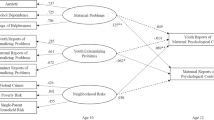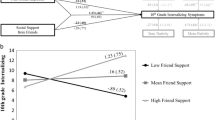Abstract
This study evaluated a transactional model of youth anxious solitude and peer and maternal relations from 3rd through 7th grade. Participants were 230 American youth (57% girls) selected for longitudinal study from a screening sample recruited from public schools (N = 688). Peers reported on anxious solitude and peer exclusion and youth reported on their mother’s overcontrol annually. In an autoregressive cross-lagged panel analytic model peer exclusion predicted incremental increases in anxious solitude during elementary school and after the middle school transition. Additionally, anxious solitude evoked incremental increases in maternal overcontrol during elementary school. Finally, anxious solitude in 4th grade mediated the positive indirect relation between peer exclusion in 3rd grade and maternal overcontrol in 5th grade. These results suggests that peer relations can indirectly effect mothering via increased youth anxious solitude over time. Taken together, evidence supports a Transactional Model of anxious solitude development. Additionally, consistent with previous evidence, elevated youth anxious solitude at the end of elementary school in 5th grade predicted decreased peer exclusion after the middle school transition in 6th grade when youth experience a fresh start with peer relations. Nonetheless, youth (especially girls) demonstrated greater year-to-year stability in anxious solitude across the first two years of middle school than in the last three years of elementary school.

Similar content being viewed by others
References
Albano, A. M., & Krain, A. (2005). Anxiety and anxiety disorders in girls. In D. J. Bell, S. L. Foster, & E. J. Mash (Eds.), Handbook of behavioral & emotional problems in girls (pp. 79–116). NY: Kluwer.
Booth-LaForce, C., Oh, W., Kennedy, A. E., Rubin, K. H., Rose-Krasnor, L., & Laursen, B. (2012). Parent and peer links to trajectories of anxious withdrawal from grades 5 to 8. Journal of Clinical Child and Adolescent Psychology, 41(2), 138–149. https://doi.org/10.1080/15374416.2012.651995.
Booth-LaForce, C., & Oxford, M. L. (2008). Trajectories of social withdrawal from grades 1 to 6: Prediction from early parenting, attachment, and temperament. Developmental Psychology, 44(5), 1298–1313. https://doi.org/10.1037/a0012954.
Borelli, J. L., Margolin, G., & Rasmussen, H. F. (2015). Parental overcontrol as a mechanism explaining the longitudinal association between parent and child anxiety. Journal of Child and Family Studies, 24(6), 1559–1574. https://doi.org/10.1007/s10826-014-9960-1.
Bretherton, I., & Munholland, K. A. (2008). Internal working models in attachment relationships: Elaborating a central construct in attachment theory. In Handbook of attachment: Theory, research, and clinical applications, 2nd ed. (pp. 102–127). New York, NY, US: The Guilford Press.
Byrne, B. M. (1989). A primer of LISREL: Basic applications and programming for confirmatory factor analytic models. New York: Springer-Verlag.
Cicchetti, D., & Rogosch, F. A. (1999). Conceptual and methodological issues in developmental psychopathology research. In P. C. Kendall & J. N. Butcher (Eds.), Handbook of research methods in clinical psychology (2nd ed., pp. 433–465). New York, NY: Wiley.
Edwards, S. L., Rapee, R. M., & Kennedy, S. (2010). Prediction of anxiety symptoms in preschool-aged children: Examination of maternal and paternal perspectives. Journal of Child Psychology and Psychiatry, 51(3), 313–321. https://doi.org/10.1111/j.1469-7610.2009.02160.x.
Gazelle, H. (2008). Behavioral profiles of anxious solitary children and heterogeneity in peer relations. Developmental Psychology, 44(6), 1604–1624. https://doi.org/10.1037/a0013303.
Gazelle, H., & Druhen-Shell, M. J. (2017). Profiles of anxious solitary children: Predicting longitudinal peer relations trajectories. Merrill-Palmer Quarterly, 63(2), 237–281. https://doi.org/10.13110/merrpalmquar1982.63.2.0237.
Gazelle, H., & Faldowski, R. A. (2019). Multiple trajectories in anxious solitary youths: The middle school transition as a turning point in development. Journal of Abnormal Child Psychology, 47(7), 1135–1152. https://doi.org/10.1007/s10802-019-00523-8.
Gazelle, H., & Ladd, G. W. (2003). Anxious solitude and peer exclusion: A diathesis-stress model of internalizing trajectories in childhood. Child Development, 74(1), 257–278. https://doi.org/10.1111/1467-8624.00534.
Gazelle, H., Peter, D., & Karkavandi, M. A. (2014). Commentary: Bashful boys and coy girls: A review of gender differences in childhood shyness. Sex Roles, 70(7–8), 285–308. https://doi.org/10.1007/s11199-014-0361-0.
Gazelle, H., Putallaz, M., Li, Y., Grimes, C. L., Kupersmidt, J. B., & Coie, J. D. (2005). Anxious solitude across contexts: Girls' interactions with familiar and unfamiliar peers. Child Development, 76(1), 227–246. https://doi.org/10.1111/j.1467-8624.2005.00841.x.
Gazelle, H., & Rubin, K. H. (2019). Social withdrawal and anxiety in childhood and adolescence: Interaction between individual tendencies and interpersonal learning mechanisms in development: Introduction to the special issue. Journal of Abnormal Child Psychology, 47(7), 1101–1106. https://doi.org/10.1007/s10802-019-00557-y.
Gazelle, H., Workman, J. O., & Allan, W. (2010). Anxious solitude and clinical disorder in middle childhood: Bridging developmental and clinical approaches to childhood social anxiety. Journal of Abnormal Child Psychology, 38, 1–17. https://doi.org/10.1007/s10802-009-9343-z.
Hane, A. A., Cheah, C., Rubin, K. H., & Fox, N. A. (2008). The role of maternal behavior in the relation between shyness and social reticence in early childhood and social withdrawal in middle childhood. Social Development, 17(4), 795–811.
Hastings, P. D., Grady, J. S., & Barrieau, L. E. (2019). Children's anxious characteristics predict how their parents socialize emotions. Journal of Abnormal Child Psychology, 47, 1225–1238.
Hastings, P. D., & Rubin, K. H. (1999). Predicting mothers' beliefs about preschool-aged children's social behavior: Evidence for maternal attitudes moderating child effects. Child Development, 70(3), 722–741.
Hu, L., & Bentler, P. M. (1999). Cutoff criteria for fit indexes in covariance structure analysis: Conventional criteria versus new alternatives. Structural Equation Modeling, 6(1), 1–55.
Ladd, G. W., Ettekal, I., & Kochenderfer-Ladd, B. (2019). Longitudinal changes in victimized youth’s social anxiety and solitary behavior. Journal of Abnormal Child Psychology, 47(7), 1211–1223. https://doi.org/10.1007/s10802-018-0467-x.
Magnusson, D., & Stattin, H. (2006). The person in context: A holistic-interactionistic approach. In W. Damon & R. M. Lerner (Eds.), Handbook of child psychology: Vol 3. Social, emotional, and personality development (6th ed., pp. 400–464). New York: Wiley.
Margolies, P. J., & Weintraub, S. (1977). The revised 56-item CRPBI as a research instrument: Reliability and factor structure. Journal of Clinical Psychology, 33(2), 471–476.
Marks, P. E. L., Babcock, B., Cillessen, A. H. N., & Crick, N. R. (2013). The effects of participation rate on the internal reliability of peer nomination measures. Social Development, 22(3), 609–622. https://doi.org/10.1111/j.1467-9507.2012.00661.x.
Masten, A. S., & Cicchetti, D. (2010). Developmental cascades. Development and Psychopathology, 22, 491–495. https://doi.org/10.1017/S0954579410000222.
Oh, W., Rubin, K. H., Bowker, J. C., Booth-LaForce, C., Rose-Krasnor, L., & Laursen, B. (2008). Trajectories of social withdrawal from middle childhood to early adolescence. Journal of Abnormal Child Psychology, 36(4), 553–566.
Rapee, R. M., Schniering, C. A., & Hudson, J. L. (2009). Anxiety disorders during childhood and adolescence: Origins and treatment. Annual Review of Clinical Psychology, 5, 335–365.
Rubin, K. H., Burgess, K. B., & Hastings, P. D. (2002). Stability and social-behavioral consequences of toddlers' inhibited temperament and parenting behaviors. Child Development, 73(2), 483–495.
Rubin, K. H., Coplan, R. J., & Bowker, J. C. (2009). Social withdrawal in childhood. Annual Review of Psychology, 60(1), 141–171. https://doi.org/10.1146/annurev.psych.60.110707.163642.
Rubin, K. H., Nelson, L. J., Hastings, P., & Asendorpf, J. (1999). The transaction between parents' perceptions of their children's shyness and their parenting styles. International Journal of Behavioral Development, 23(4), 937–958. https://doi.org/10.1080/016502599383612.
Rubin, K. H., Wojslawowicz, J. C., Rose-Krasnor, L., Booth-LaForce, C., & Burgess, K. B. (2006). The best friendships of shy/withdrawn children: Prevalence, stability, and relationship quality. Journal of Abnormal Child Psychology, 34(2), 143–157. https://doi.org/10.1007/s10802-005-9017-4.
Rudolph, K. D., & Hammen, C. (1999). Age and gender as determinants of stress exposure, generation, and reactions in youngsters: A transactional perspective. Child Development, 70(3), 660–677.
Shell, M. D., Gazelle, H., & Faldowski, R. A. (2014). Anxious solitude and the middle school transition: A diathesis × stress model of peer exclusion and victimization trajectories. Developmental Psychology, 50(5), 1569–1583. https://doi.org/10.1037/a0035528.
Shrout, P. E., & Bolger, N. (2002). Mediation in experimental and nonexperimental studies: New procedures and recommendations. Psychological Methods, 7(4), 422–445.
Spangler, T., & Gazelle, H. (2009). Anxious solitude, unsociability, and peer exclusion in middle childhood: A multitrait-multimethod matrix. Social Development, 18(4), 833–856. https://doi.org/10.1111/j.1467-9507.2008.00517.x.
Terry, R., & Coie, J. D. (1991). A comparison of methods for defining sociometric status among children. Developmental Psychology, 27, 867–880. https://doi.org/10.1037/0012-1649.27.5.867.
Wichmann, C., Coplan, R. J., & Daniels, T. (2004). The social cognitions of socially withdrawn children. Social Development, 13(3), 377–392. https://doi.org/10.1111/j.1467-9507.2004.00273.x.
Acknowledgements
Thanks to the children, school staff, and families who participated in this research and to the members of the Social Development Lab who demonstrated such dedication to this research program. Thanks also to Dr. Thomas Ledermann for his generosity with statistical consultation.
Funding
This research was supported by grant 1K01MH076237 from the National Institute of Mental Health to Heidi Gazelle and by Florida State University.
Author information
Authors and Affiliations
Corresponding author
Ethics declarations
Conflict of Interest
The authors have no conflicts of interest to report.
Ethical Approval
Measures and procedures were approved by the University of North Carolina at Greensboro IRB.
Informed Consent
Participants were 230 youth (57% girls) with active informed parental consent who attended seven public elementary schools in 3rd grade in a suburban to rural region of the Southeastern United States.
Additional information
Publisher’s Note
Springer Nature remains neutral with regard to jurisdictional claims in published maps and institutional affiliations.
Rights and permissions
About this article
Cite this article
Gazelle, H., Cui, M. Relations Among Anxious Solitude, Peer Exclusion, and Maternal Overcontrol from 3rd Through 7th Grade: Peer Effects on Youth, Youth Evocative Effects on Mothering, and the Indirect Effect of Peers on Mothering via Youth. J Abnorm Child Psychol 48, 1485–1498 (2020). https://doi.org/10.1007/s10802-020-00685-w
Published:
Issue Date:
DOI: https://doi.org/10.1007/s10802-020-00685-w




